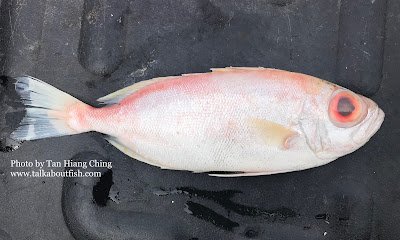Bigeyes
Overview
Bigeyes or catalufas are members of the Priacanthidae family. They are found in the tropical and subtropical Atlantic, Indian, and Pacific oceans. They are are recognized by their extremely large eyes, large upturned mouth and spiny scales. Their pelvic fins are in advance of pectoral fins and broadly attached to their belly by membrane.Bigeyes occur near coral reefs or rock formations but occasionally in more open areas at depths of 5 to 400 m, or deeper. They feed primarily on crustaceans, small cephalopods, polychaetes, and small fishes.
Worldwide, there are 4 genera and about 19 species.
Common Bigeyes Species
Scientific Name: Priacanthus hamrur (Forsskål, 1775)
English Name: Moontail Bullseye, Lunartail Bigeye, Crescent-tail Bigeye, Goggle Eye
Chinese Name | 鱼类中文名: 金目大眼鯛 (Jīnmù dà yǎn diāo), 宝石大眼鲷 (Bǎoshí dà yǎn diāo), 红目鲢 (Hóng mù lián), 大眼鸡鱼 (Dà yǎn jī yú)
Japanese Name | 和名: ホウセキキントキ (Hōseki kintoki)
Malay Name | Nama Melayu Malaysia: Ikan Lolong Bara, Temenggong, Barau-barau Laut, Mata Besar, Panda Merah, Lolong-bara Ekor Sabit
Indonesian Name | Nama Indonesia: Ikan Swanggi, Serindang, Saga Bini, Gondang, Beseng, Cemawul
Thai Name | ชื่อสามัญภาษาไทย: ปลาตาหวานหางวงเดือน (Plā tāh̄wān h̄āng wngdeụ̄xn)
Main Identification Features: Anterior profile symmetrical, tip of protruding lower jaw about on level with midline of body when mouth tightly closed. Poorly developed preopercular spine. Pelvic fins long, reaching posterior to spinous portion of anal fin. Distinctly emarginate caudal fin. Capable of rapidly changing body colour.
Size: Maximum total length about 45 cm, commonly to 35 cm.
Habitat and Ecology: Occurs near coral and rocky reefs with sheltered environments at depths from 15 m to 250 m. Feeds on small fish, crustaceans, and other small invertebrates.

